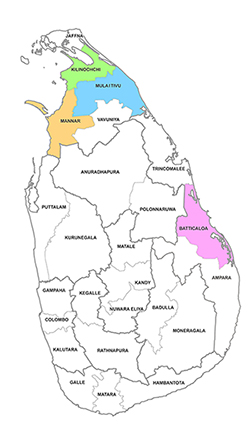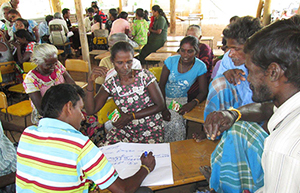Background

Three decades of conflict in Sri Lanka ended in May 2009, displacing more than 450,000 people. In addition to the loss of family assets and livelihoods, the displacements also forced people into poverty. Due to the prolonged conflict, infrastructure has suffered seriously from damage and neglect, substantially affecting the living conditions of the resettled people. The people who have suffered the most are those in rural areas affected directly by the conflict in the North and East.
The current accelerated Rehabilitation Programme of the Government of Sri Lanka focuses on rehabilitation and reconstruction of major infrastructure such as the main road networks, major water supply schemes, irrigation systems, railways and power distribution. However, investment on small community infrastructure is inadequate.
The Project
The Project for “Rehabilitation of Community Infrastructure, Improvement of Livelihoods and Empowerment of Women in the Northern and Eastern Provinces (RCI)” is framed within the overall objective of contributing to the sustainable rehabilitation and reconstruction of conflict affected people of Sri Lanka with a focus on assisting beneficiaries to overcome the ongoing hardships caused by the lack of basic services, whilst rebuilding human capital.
The RCI project will build upon the experiences of the ongoing Project for Rehabilitation of Community Infrastructure and Facilities in the Conflict Affected Areas in Northern Province (RCIF), also funded by the Government of Japan, with specific focus on access to economic opportunities and the empowerment of women.
While the RCIF project is focused on the conflict affected districts of Killinochchi and Mullaitivu, the RCI project will expand to cover other lagging districts that have been affected by the conflict, namely Mannar in the North and Batticaloa in the East.
The project will be implemented in approx. 90 villages and benefit approximately 116,000 people (31,300 families).
Objectives
- Rehabilitate and reconstruct damaged or destroyed small community infrastructure including multipurpose community centers, preschools, storm water drainage, rainwater harvesting systems, and planting of trees.
- Improve economic opportunities through improving access roads, storage facilities, irrigation channels and skills development in the communities.
- Empower women through vocational and leadership training and through access to credit facilities.
- Educate communities to learn how to live with wild elephants and construct infrastructure to address the issue.
The Project Approach

UN-Habitat’s methodology for sustainable recovery from disasters, the “People’s Process” model, will be adopted to implement this project. This process involves mobilizing the target group into an integrated community. The project interventions will be developed at Community Action Planning (CAP) workshops where the community members participate in the decision making process. Un-Habitat will contract with the beneficiaries using community contracts (community implementation agreements), thereby creating ownership and cost effectiveness in the assets. Physical works will be carried out by CBOs, with technical input from UN-Habitat.
Complex work beyond the skills of the local community will be contracted out by the CBOs to small local contractors through the standard bidding process, with the community and technical staff of UN-Habitat responsible for supervising the implementation.
UN-Habitat will partner with a specialist Japanese NGO to undertake value added trainings for women’s capacity building as well as the private sector for the introduction of innovative construction material.
Key expected results
- ・18 community centers reconstructed
- ・18 preschools reconstructed
- ・36 preschool teachers trained
- ・18 Rain Water Harvesting systems provided for public buildings
- ・10 community storage facilities constructed
- ・10 small irrigation channels constructed
- ・10km storm water drainage rehabilitated
- ・30km internal roads rehabilitated
- ・63,500 trees planted
Development Partners/ Partners
Development Partner: Government of Japan
Partners: Community Based Organisations (CBOs), Local Government, Divisional Coordination Committees.
- Catalytic Support to Peacebuilding in Sri Lanka
- Preparation of the Resettlement Plan (RP) for Households Affected by the Rehabilitation of the Kelani Valley (KV) Railway Line in Sri Lanka (Phase I)
- Emergency Shelter Relief for Flood and Landslide Affected Households in Kalutara and Galle Districts of Sri Lanka
- The State of Sri Lankan Cities Report
- Human Development Initiative through Empowerment and Settlement Improvement in the Plantation Settlements in Sri Lanka
- Indian Housing Project in Central and Uva Provinces
- Emergency Shelter Relief for Flood Affected Families in Colombo and Gampaha Districts in Western Province, Sri Lanka (Completed)
- Sustainable Resettlement through Community-Driven Improvement of the Learning Environment in Mannar District, Sri Lanka
- Support My School: Supporting Schools in Northern Sri Lanka with Access to Water and Sanitation Facilities (Completed)
- Project for Rehabilitation of Community Infrastructure, Improvement of Livelihoods and Empowerment of Women in the Northern and Eastern Provinces (RCI) (Completed)
- Rainwater Harvesting in a Water Scarce Small Village in Northern Sri Lanka (Completed)
- Climate Resilient Action Plans for Coastal Urban Areas (Completed)
- Disaster Resilient City Development Strategies for Sri Lankan Cities (Completed)
- Disaster Resilient City Development Strategies for Four Cities in the Northern and Eastern Provinces of Sri Lanka (Phase II) (Completed)
- Rehabilitation of Community Infrastructure and Facilities in the Conflict Affected Areas in Northern Province of Sri Lanka (Completed)
- Improving Living Conditions in Returnee Areas of Sri Lanka through Housing (Completed)
- Indian Housing Project (Completed)
- Support to Conflict Affected People through Housing (Completed)
- Shelter Support to Conflict-affected IDPs in the North of Sri Lanka (Completed)
- Jaffna Tsunami Recovery and Reconstruction Project (Completed)
- Community Recovery and Reconstruction Partnership to Support the People's Process of Rebuilding (Completed)
- Reconstruction of Fish Market in Galle (Completed)
- Rebuilding Community Infrastructure and Shelter in Tsunami-Affected Areas (Completed)
- Lunawa Lake Environment Improvement and Community Development Project (Completed)
- Pro-Poor Partnerships for Participatory Settlement Upgrading (Completed)
- Early Recovery Shelter for IDPs in Batticaloa (Completed)
- Support to the Urbanization Framework
- Post Disaster Housing Coordination Project (Completed)
- Sustainable Cities Programme (Completed)
- Urban Governance Support Project (UGSP) (Completed)
- Rebuilding Communities in North East Sri Lanka (Completed)
- Urban Poverty Reduction Strategy - Colombo (Completed)






































